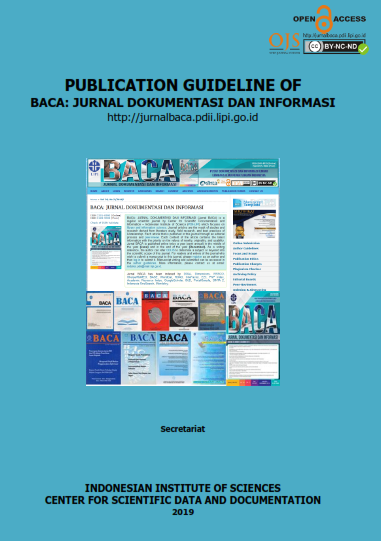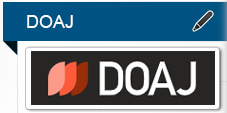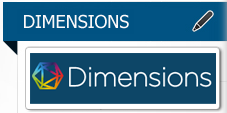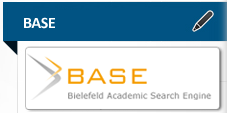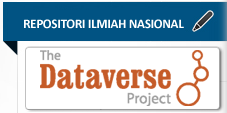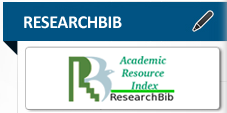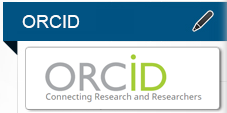PERAN GAWAI MOBILE DALAM MENDUKUNG LAYANAN INFORMASI PERPUSTAKAAN DIGITAL YANG TERPERSONALISASI
Abstract
Personalized information service is an information service delivered by digital libraries so that users can only get information according to their needs online. This article is a conceptual study that examines the role of mobile devices as technology to support personalized information services from the aspects of user data collection and service delivery. Data obtained through literature review of scientific articles that have relevance to the main concept. The results showed that mobile devices have a role in sending data and accessing library services efficiently. As a two-way communication medium, mobile devices can send various forms of feedback to the library which eventually become data for further analysis. As for service access, mobile devices can support mobile applications so that there are several traditional services that can be accessed online anywhere and anytime. Not only data in the form of text, technological developments have been able to analyze data in other types, one of which is in the form of voice. The development of technology in the 4.0 industrial revolution has also become an aspect that encourages efficiency because it can bring about automation in the aspects of data collection and access to library services.
Keywords
Full Text:
PDF (Bahasa Indonesia)References
Alfaresi, S.H., & Hone, K. 2015. The Intention to Use Mobile Digital Library Technology: A Focus Group Study in the United Arab Emirates. International Journal of Mobile Human Computer Interaction, 7(2): 23–42. https://doi.org/10.4018/ijmhci.2015040102.
Asif, M., & Krogstie, J. 2012. Research Issues in Personalization of Mobile Services. International Journal of Information Engineering and Electronic Business, 4(4): 1–8. https://doi.org/10.5815/ijieeb.2012.04.01. Asif, M., & Krogstie, J.
Asif, M., & Krogstie, J. 2013. Role of Personalization in Mobile Services Adoption. International Conference on Multimedia and Human Computer Interaction, 59: 1–10.
Bal, H.C., & Erkan, C. 2019. Industry 4.0 and Regional Transformations. Procedia Computer Science 158: 625–31. https://doi.org/10.1016/j.procs.2019.09.096.
Buarki, H.J., & Ahmad-Dar, S. 2019. Anytime, Anywhere Access to Information Resources: A Case Study from Kuwait. Library Hi Tech News, 36(7): 20–24. https://doi.org/10.1108/LHTN-08-2019-0049.
Cronin, P., Ryan, F., & Coughlan, M. 2008. Undertaking a Literature Review: A Step-by-Step Approach. British Journal of Nursing, 17(1): 38–43. https://doi.org/10.12968/bjon.2008.17.1.28059.
Digital-Library-Federation. D. 2020. A Working Definition of Digital Library. https://old.diglib.org/about/dldefinition.htm#:~:text=%22Digital libraries are organizations that,are readily and economically available.
Dunlop, M., & Brewster, S. 2009. The Challenge of Mobile Devices for Human Computer Interaction. Personal and Ubiquitous Computing, 6(4): 235–36. https://doi.org/10.1007/s007790200022.
Gauch, S., Speretta, M., Chandramouli, A., & Micarelli, A. 2007. User Profiles for Personalized Information Access. Lecture Notes in Computer Science (Including Subseries Lecture Notes in Artificial Intelligence and Lecture Notes in Bioinformatics) 4321 LNCS: 54–89. https://doi.org/10.1007/978-3-540-72079-9_2.
Gbotosho, A.S. 2019. The Electronic Library Services and Its Patronage Among Undergraduates In The Faculty Of Health Sciences, Osun State University, Osogbo, Osun State, Nigeria. International Journal of Library and Information Science Studies, 5(1): 41–54.
Ghaphery, J., Kesselman, M., & Watstein, S.B. 2001. Personalized Information Clients: Short Answers to Simple Questions about ‘My Library’ Services. Reference Services Review, 29 (4): 276–81. https://doi.org/10.1108/EUM0000000006489.
Houhamdi, Z., & Athamena, B. 2019. Impacts of Information Quality on Decision-Making. Global Business and Economics Review, 21(1): 26. https://doi.org/10.1504/gber.2019.10017577.
Jeevan, V.K.J., & Padhi, P. 2006. “A Selective Review of Research in Content Personalization.” Library Review, 55(9): 556–86. https://doi.org/10.1108/00242530610706761.
Kamilaris, A., & Pitsillides, A. 2016. Mobile Phone Computing and the Internet of Things: A Survey. IEEE Internet of Things Journal, 3(6): 885–98. https://doi.org/10.1109/JIOT.2016.2600569.
Kao, S.C., & Hsing-Wu, C. 2012. PIKIP DL A Personalized Information and Knowledge Integration Platform for DL Service. Library Hi Tech, 30(3): 490–512. https://doi.org/10.1108/07378831211266627.
Kayaba, K., Oguri, H., & Yamaoka, Y. 2020. Evaluation of Secure Remote Offering Service for Information Bank. CODASPY 2020 - Proceedings of the 10th ACM Conference on Data and Application Security and Privacy, 144–46. https://doi.org/10.1145/3374664.3379526.
Khaddar, M.A.E., & Boulmalf, M. 2017. Smartphone: The Ultimate IoT and IoE Device. Smartphones from an Applied Research Perspective. https://doi.org/10.5772/intechopen.69734.
Kubat, G. 2017. The Mobile Future of University Libraries and an Analysis of the Turkish Case. Information and Learning Science, 118(3–4): 1–23. https://doi.org/10.1108/ILS-09-2016-0063.
Li, Q., Lizhen, L., & Yue, H. 2007. Analysis of Personalized Information Service System for Digital Libraries. Proceedings of the 2007 1st International Symposium on Information Technologies and Applications in Education, ISITAE 2007, 233–37. https://doi.org/10.1109/ISITAE.2007.4409277.
Li, S., Hao, Z., Ding, L., & Xu, X. 2019. Research on the Application of Information Technology of Big Data in Chinese Digital Library. Library Management, 40(8–9): 518–31. https://doi.org/10.1108/LM-04-2019-0021.
Liu, L., Su, X., Akram, U., & Abrar, M. 2020. The User Acceptance Behavior to Mobile Digital Libraries. International Journal of Enterprise Information Systems, 16(2): 38–53. https://doi.org/10.4018/IJEIS.2020040103.
Mansouri, A., & Soleymani, N.A. 2019. Assessing Mobile Application Components in Providing Library Services. Electronic Library, 37(1): 49–66. https://doi.org/10.1108/EL-10-2018-0204.
Mishaal, D.A., & Abu-shanab, E. 2015. The Effect of Using Social Media in Governments: Framework of Communication Success, 357–64. https://doi.org/10.15849/icit.2015.0069.
Mohammadi, M., & Yegane, M.E. 2018. IOT: Applied New Technology in Academic Libraries. International Conference on Distributed Computing and High Performance (DCHPC), 1–12. https://www.academia.edu/39875574/IOT_Applied_New_Technology_in_Academic_Libraries.
Nakagawa, Y., Matsuda, Y., & Ogi, T. 2016. Personalized Information Service Model that Reflects Individual’s Will. Serviceology for Designing the Future, 329–44. https://doi.org/10.1007/978-4-431-55861-3_23.
Neuman, D. 2008. Music Camp Politics in the Classroom: Music, Politics and Protest. Music and Politics, 2(2). https://doi.org/10.3998/mp.9460447.0002.205.
Ni, M., & Zhang, Y. 2019. Development of Mobile Library Based on the Internet+ in China, 265–68.
Noh, Y. 2015. Imagining Library 4.0: Creating a Model for Future Libraries. Journal of Academic Librarianship, 41(6): 786–97. https://doi.org/10.1016/j.acalib.2015.08.020.
Pang, N., & Yan, F. 2012. The Research on Personalized Service of Digital Library Based on Data Mining. Proceedings of the 2012 National Conference on Information Technology and Computer Science, CITCS 2012, 572–75. https://doi.org/10.2991/citcs.2012.221.
Petticrew, M., & Roberts, H. 2008. Systematic Reviews in the Social Sciences: A Practical Guide. Systematic Reviews in the Social Sciences: A Practical Guide. https://doi.org/10.1002/9780470754887.
Prasetyo, E., et al. 2016. Model Bibliografi Berbasis Linked Data Pada Perpustakaan Digital. Makalah Seminar Nasional Teknologi Informasi Dan Multimedia Yogyakarta, 109–14.
Ridley, D. 2012. The Literature Review: A Step-by-Step for Students. London: Sage Publications.
Rowley, J. 2007. The Wisdom Hierarchy: Representations of the DIKW Hierarchy. Journal of Information Science, 33(2): 163–80. https://doi.org/10.1177/0165551506070706.
Santha, K.R. 2013. Mobile Phones: A New Dimension in Library Services. www.ceserp.com/cp-jour.
Sharman, A. 2014. Roving Librarian: The Suitability of Tablets in Providing Personalized Help Outside of the Traditional Library. New Review of Academic Librarianship, 20(2): 185–203. https://doi.org/10.1080/13614533.2014.914959.
Singh, K., & Nikandia, P.K. 2017. Role of Mobile Technology and Their Application in Library Services in Digital Era. Journal of Library & Information Science, 7: 157–66.
Stojanovski, J., & Papić, A. 2012. Information Services in Academic Libraries: Browsing Services vs Searching Services, 85–90.
Taylor, K., & Corrall, S. 2007. Personalized Service? Changing the Role of the Government Librarian. Journal of Information Science, 33(3): 298–314. https://doi.org/10.1177/0165551506070728.
Tutu, J.M. 2016. Provision of Digital Reference Services in Academic Libraries in Kenya: A Review. Regional Journal of Information and Knowledge Management, 2(1): 16–28.
Wang, D.X. 2016. Information Service in the Big Data Era and Development Strategies for University Libraries, 664–68. https://doi.org/10.2991/sschd-16.2016.128.
Wang, F. 2011. On Personalized Service of Mobile Phone Library Based on Contextual Model. Proceedings - PACCS 2011: 2011 3rd Pacific-Asia Conference on Circuits, Communications and System, 0–3. https://doi.org/10.1109/PACCS.2011.5990178.
Wang, X., Li, J., Yang, M., Chen, Y., & Xu, X. 2018. An Empirical Study on the Factors Influencing Mobile Library Usage in IoT Era. Library Hi Tech, 36(4): 605–21. https://doi.org/10.1108/LHT-01-2018-0008.
Wang, X., Yang, M., Li, J., & Wang, N. 2018. Factors of Mobile Library User Behavioral Intention from the Perspective of Information Ecology. Electronic Library, 36(4): 705–20. https://doi.org/10.1108/EL-03-2017-0046.
Wei, Q., & Yang, Y. 2017. WeChat Library: A New Mode of Mobile Library Service. Electronic Library, 35(1): 198–208. https://doi.org/10.1108/EL-12-2015-0248.
Zhang, Q. & Wang, X. 2014. Digital Library of Personalized Information Services Approach and Countermeasures. Proceedings of the 2014 International Conference on Education, Management and Computing Technology 100 (Icemct): 404–6. https://doi.org/10.2991/icemct-14.2014.96.
Zhao, Y., Deng, S., Gao, T., & Zhou, R. 2016. Research on User Needs for Mobile Information Services in Chinese University Libraries: Comparison between Existing and Potential Users. Electronic Library, 34(4): 617–35. https://doi.org/10.1108/EL-12-2014-0222.
DOI: https://doi.org/10.14203/j.baca.v42i1.763
Data citation
Sugiono, Shiddiq, 2021, "PERAN GAWAI MOBILE DALAM MENDUKUNG LAYANAN INFORMASI PERPUSTAKAAN DIGITAL YANG TERPERSONALISASI", https://hdl.handle.net/20.500.12690/RIN/OZTYI0, RIN Dataverse, DRAFT VERSION
Copyright (c) 2021 BACA: JURNAL DOKUMENTASI DAN INFORMASI

This work is licensed under a Creative Commons Attribution-NonCommercial-NoDerivatives 4.0 International License.











